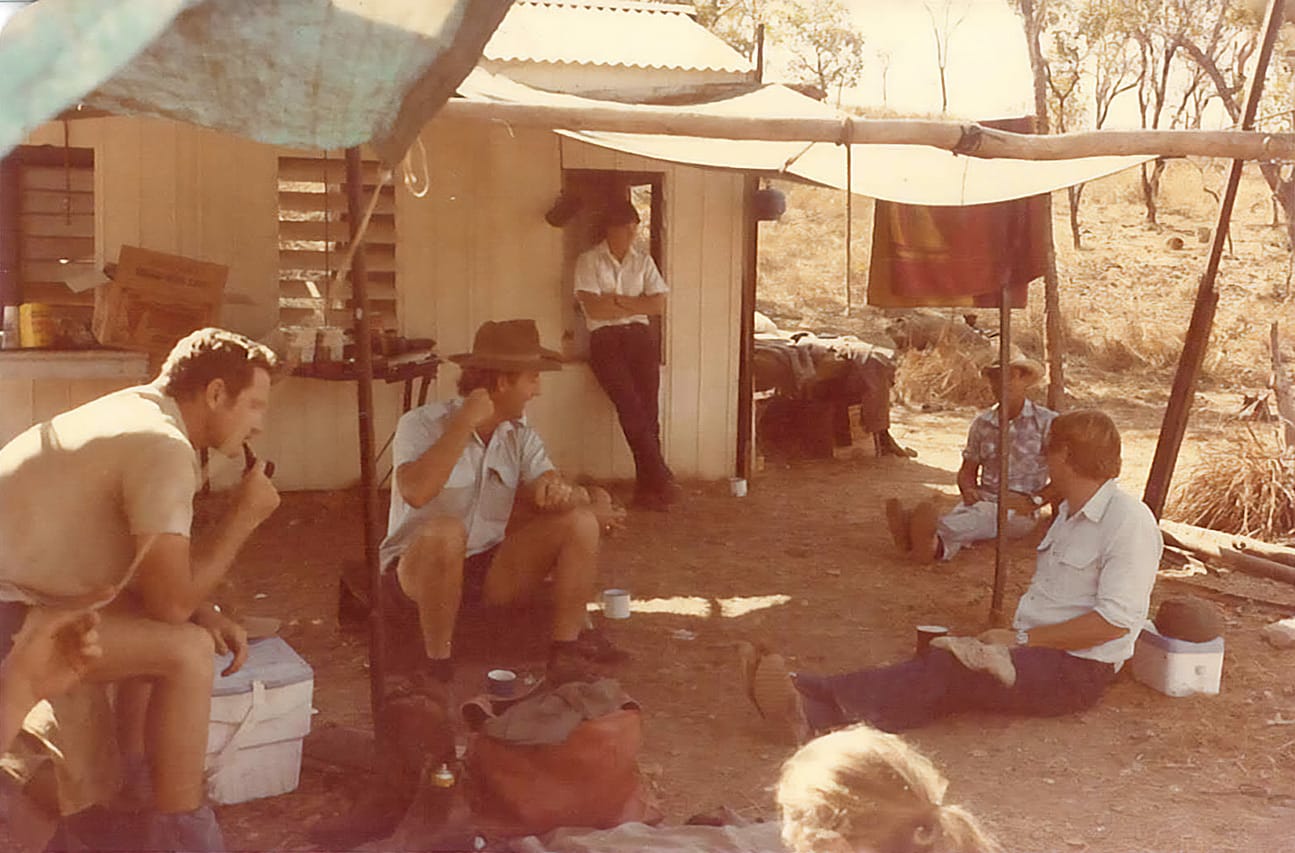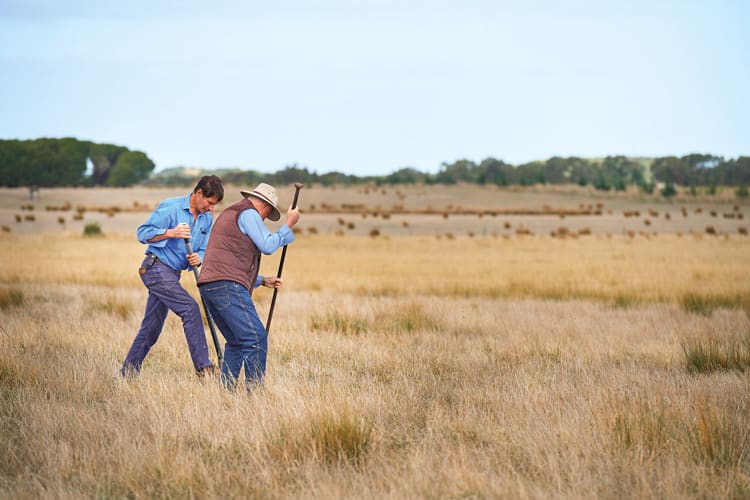
Grassroots mentor
Terry McCosker has devoted more than 50 years to improving land management and now educates farmers in regenerative agriculture.
STORY + PHOTOS CORMAC HANRAHAN | OUTBACK MAGAZINE
Terry McCosker OAM plunges a spade into the earth and works free a tussock of phalaris grass. On bended knee, he examines the clump of newly exposed soil held together by a filigree of fine roots and likes what he sees. “Not bad for this time of year,” he says.
A small mob of Angus bulls is chewing their cud, unaware they are intimately involved in a slowmoving revolution creeping across the Australian farming landscape. While the movement has only recently become accepted practice, Terry has been espousing holistic land management principles for the best part of 4 decades and is unofficially known as the ‘father’ of regenerative agriculture in Australia.
At its core, regenerative agriculture is about connecting farmers, who Terry describes as ‘the most noble professionals in the world’, with their true purpose – healthy food production. While there are many pathways to improvement, Terry believes the foundation of any good farm is underfoot. “Regenerative agriculture is about improving soil health, which then improves plant health, which in turn improves animal health, which improves human and economic and health, which then goes on to improve community wellbeing,” Terry says. “It’s about outcomes rather than inputs.”
For the past 37 years, the vehicle for Terry’s teachings has been Resource Consulting Services (RCS), the company he started with the late agricultural economist and scientist David Hanlon in 1985. Since the very first workshop in Yeppoon, Qld, Terry has remained laser focused on helping to improve the lives and lands of Australian farmers. “I got my passion for the land and agriculture from Mum,” he says. “My compassion for humanity came from Dad.” Growing up on a ‘starvation’ block near Proston, about 300km north-west of Brisbane, with 30 cows and 5 siblings, Terry left the farm at a young age to work. “I wanted to go back to the farm, but Dad said, ‘none of you is coming back here’,” Terry says.
After failing primary school and thinking himself “pretty dumb”, Terry encountered a high school teacher who “rescued” him. “Having John Fletcher as my ag teacher in 1964 was a turning point,” he says. “I was one of those guys who would have been on the scrap heap without a really good teacher.”
Excelling at ag subjects, Terry left school early and joined the Queensland Department of Primary Industries (DPI) as a cadet. In his first couple of years with the department his active mind and raw enthusiasm saw him write an unsolicited paper on pangola, a new type of grass at the time. “I just put down everything I knew about it,” he says. “I didn’t know about using references or things like that.” A senior staff member, Dr Joe Ebersohn, picked it up, covered it in red ink and helped Terry get it published. He was only 19 and remains the youngest employee of Queensland DPI to be sole author of a peer-reviewed paper.
Far from being feted, Terry’s youth ensured he was met with tremendous opposition from within sections of the department, and he once again became aware of the value of a good mentor. “Without Joe, my paper would have gathered dust in a bottom drawer.” It wasn’t the last time Terry would encounter opposition from within the establishment.
In 1978, after 11 years at the DPI, Terry applied for a job as the ‘resident grass grower’ on Mount Bundey (now spelt Bundy by the current owners), a large cattle operation in the NT owned by US corporate W.R. Grace & Co. He spent 6 months roaming the property looking for improved pastures but found mostly weeds. Terry wrote a report recommending they sell up and get out. Instead, the owners asked for a solution. “I said, ‘Give me a million bucks and 3 years and I’ll sort it out’,” he says. “It was a throwaway line, but they said, ‘OK’.”

looking for improved pastures but found mostly weeds. Terry wrote a report recommending they sell up and get out. Instead, the owners asked for a solution. “I said, ‘Give me a million bucks and 3 years and I’ll sort it out’,” he says. “It was a throwaway line, but they said, ‘OK’.”
What followed was a period of incredible growth, learning and opportunity that eventually led to the creation of RCS and a paradigm shift in land management. With the backing of station manager Cliff Emerson, Terry turned huge swathes of land over to research. He presented a plan to management, then realised something was wrong. “My gut was telling me something wasn’t right, but I didn’t know what it was,” he says.
He searched for a solution with former colleagues in the DPI and, when he was done, told Cliff they had to do the opposite to what he’d initially suggested. “It took a lot of convincing Cliff that I was right,” he says. “Everything they’d been trying to do was wrong and we needed a new approach to running cattle in the north. It was amazing they believed me, as I was so young.”
Terry’s approach was a complete about-turn, and the experience formed the basis for his future thinking on how to manage land. “It got me into ‘systems’ thinking, instead of linear ‘reductionist’ thinking,” he says.
At the end of the program, Terry received a contract from the NT government to write up his findings for posterity and published 18 peer-reviewed papers in 12 months, across 7 disciplines. But this time he was driven by something more powerful than youthful exuberance. “We lost our eldest child Shaun in the NT,” Terry says. “He wandered off into a river and drowned. As a result, I vowed that his life would not be in vain, and that drove me very hard for 25 years. I’m over that mad phase now, but hopefully I’ve done enough so that his life wasn’t for nothing.”
At around the time he was publishing his Mount Bundey work, Cliff put some research by scientist Dr Stan Parsons and ecologist Allan Savory under Terry’s nose. It was about rotating stock through country divided up into small chunks. Commonly referred to as cell grazing, it’s a practice that forms the basis of soil health in regenerative agriculture today. “I said this is the biggest pile of bullshit I’ve read in my life,” Terry says. “I thought there’s no way you could divide your country up into small paddocks and be mustering all the time.”
Cliff knew better than to force an opinion. “He was another fantastic mentor,” Terry says. “He led me in a direction and waited for me to sniff the air.”
In 1989, Parsons visited Australia. He and Terry put on workshops in Yeppoon, where Terry and his wife Pam had moved. With cell grazing at their core, the workshops were well attended, and word began to spread. “People on farms very quickly understood what Stan was saying,” Terry says. “He was giving them a language for what they were seeing every day.”
But in the background, a storm was brewing and Terry was heavily cautioned about his new association. “A former boss of mine said, ‘We’ve got a pile of literature 3 inches deep about how Parsons and Savory destroyed country in Africa and America and we’re gunna run them out of Australia and you’re gunna go down with them’.”

Caught in the crossfire of an impending culture war, Terry decided it was time to find out who was right. In 1990, he applied for a Churchill Fellowship to study cell grazing around the world. For 4 months, Terry followed the trail of Parsons and Savory through America and southern Africa, looking all the time at the health of the country around him. “It was clear it worked; it was life-changing,” he says.
From that point on, Terry shut out the noise and, alongside Pam, built a business around teaching transformative agricultural practices, becoming a mentor to hundreds of farmers along the way.
At a dining room table in Connewarre, Vic, Terry, along with Hamish and Amanda McFarlane, pore over a map of Te Mania Angus. For the past 7 years Terry has been chairman of the board of the highly regarded stud, helping the McFarlanes and their partners, Tom and Lucy Gubbins, grow their business.
“Terry’s made us think strategically, not just operationally,” Hamish says. “He’s helped us look at the distant horizon and set goals and made us think about what could be, and then helped us manage the culture around achieving that. The pie has to keep growing if the next generation wants to get involved.”
Others include Garlone Moulin and James Gordon who, along with James’ sister Joan, run 3,000 head of cattle across 13,000ha on Mount Pleasant, 60km west of Bowen, Qld. Twenty-two years ago, with spiralling ecological decline, low herd productivity and mounting pressure from the bank, Garlone and James were contemplating walking away from the property. After trying numerous ‘conventional’ methods to no avail, the couple plunged into regenerative agriculture through a RCS course and their lives turned around. “The renewal of our land and business is astounding,” Garlone says. “Without Terry, we wouldn’t be on the land – and we’d probably be divorced.”
While Terry came from a technical and researchbased perspective, he realised soon after starting RCS that people are the most important part of agriculture. “Helping people at crisis point get back some hope that there can be a future in agriculture through clearly defined goals is why I keep doing it,” he says. Of the approximately 85,000 farms in Australia, Terry estimates he’s ‘got across’ about 10,000 of them. In 2015 Central Queensland University awarded him an honorary doctorate in agribusiness for his work.
He hasn’t done it alone. These days, RCS employs some of its former students as teachers, and Terry and Pam’s daughter Kelly and son-in-law Adam Curcio (daughter Stacey’s husband) have stepped into leadership roles. Succession planning means Terry’s teachings can continue long after he, too, becomes soil underfoot and part of the fabric of the land. “My vision is to see Australia healed and heading in the right direction in terms of landscape and ecosystems,” he says. “I won’t see that achieved in my lifetime, but I’ve seen it begin and that’s the main thing for me.”